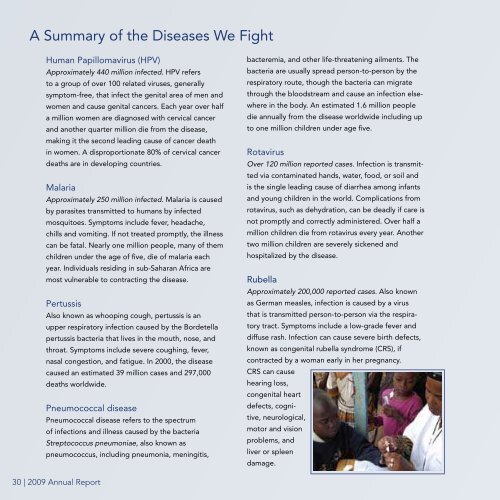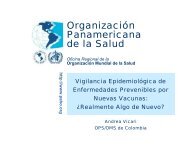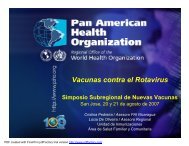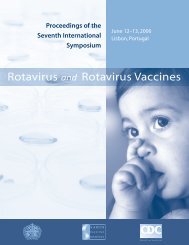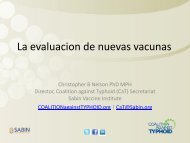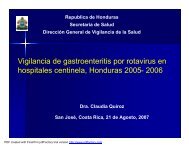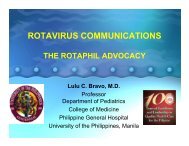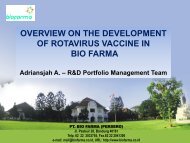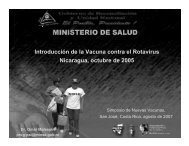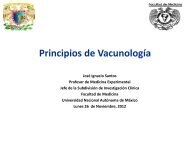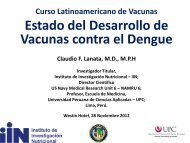2009 AnnuAl RepoRt - Sabin Vaccine Institute
2009 AnnuAl RepoRt - Sabin Vaccine Institute
2009 AnnuAl RepoRt - Sabin Vaccine Institute
You also want an ePaper? Increase the reach of your titles
YUMPU automatically turns print PDFs into web optimized ePapers that Google loves.
A Summary of the Diseases We Fight<br />
The Seven Most Common NTDs<br />
Human Papillomavirus (HPV)<br />
Approximately 440 million infected. HPV refers<br />
to a group of over 100 related viruses, generally<br />
symptom-free, that infect the genital area of men and<br />
women and cause genital cancers. Each year over half<br />
a million women are diagnosed with cervical cancer<br />
and another quarter million die from the disease,<br />
bacteremia, and other life-threatening ailments. The<br />
bacteria are usually spread person-to-person by the<br />
respiratory route, though the bacteria can migrate<br />
through the bloodstream and cause an infection elsewhere<br />
in the body. An estimated 1.6 million people<br />
die annually from the disease worldwide including up<br />
to one million children under age five.<br />
Hookworm infection<br />
Approximately 600 million infected. Hookworms<br />
are soil-transmitted parasitic worms that cause<br />
intestinal blood loss leading to severe iron deficiency<br />
anemia. Children and women are considered the<br />
most vulnerable populations because they have<br />
the lowest underlying iron reserves. Chronic<br />
Onchocerciasis (river blindness)<br />
Approximately 37 million infected. Infection is<br />
caused by a worm transmitted via the bite of a black<br />
fly. Symptoms include intense itching, disfiguring<br />
skin conditions and eye lesions that can result in<br />
blindness. The vast majority of all onchocerciasis<br />
cases are found near the rivers and fast-moving<br />
making it the second leading cause of cancer death<br />
in women. A disproportionate 80% of cervical cancer<br />
deaths are in developing countries.<br />
Malaria<br />
Approximately 250 million infected. Malaria is caused<br />
by parasites transmitted to humans by infected<br />
mosquitoes. Symptoms include fever, headache,<br />
chills and vomiting. If not treated promptly, the illness<br />
can be fatal. Nearly one million people, many of them<br />
children under the age of five, die of malaria each<br />
Rotavirus<br />
Over 120 million reported cases. Infection is transmitted<br />
via contaminated hands, water, food, or soil and<br />
is the single leading cause of diarrhea among infants<br />
and young children in the world. Complications from<br />
rotavirus, such as dehydration, can be deadly if care is<br />
not promptly and correctly administered. Over half a<br />
million children die from rotavirus every year. Another<br />
two million children are severely sickened and<br />
hospitalized by the disease.<br />
hookworm in childhood results in impaired physical<br />
development, fitness, cognition, and intelligence. In<br />
pregnancy hookworm increases maternal morbidity<br />
and mortality.<br />
Ascariasis and Trichuriasis<br />
Over one billion infected. Transmission occurs<br />
through ingestion or absorption of parasite eggs<br />
through contaminated water, food, or soil. These infections<br />
in children cause intestinal inflammation and<br />
nutritional deficiencies, leading to stunted growth,<br />
streams of sub-Saharan Africa.<br />
Lymphatic Filariasis (elephantiasis)<br />
Approximately 120 million<br />
infected. Infection is caused by<br />
mosquito-borne filarial worms that<br />
damage the lymphatic system,<br />
causing gross disfiguration and<br />
incapacitation from swollen limbs<br />
and genitals as well as thickened,<br />
rough skin. The worms’ larvae circulate in the skin,<br />
year. Individuals residing in sub-Saharan Africa are<br />
most vulnerable to contracting the disease.<br />
Pertussis<br />
Also known as whooping cough, pertussis is an<br />
upper respiratory infection caused by the Bordetella<br />
pertussis bacteria that lives in the mouth, nose, and<br />
throat. Symptoms include severe coughing, fever,<br />
nasal congestion, and fatigue. In 2000, the disease<br />
caused an estimated 39 million cases and 297,000<br />
deaths worldwide.<br />
Pneumococcal disease<br />
Pneumococcal disease refers to the spectrum<br />
of infections and illness caused by the bacteria<br />
Streptococcus pneumoniae, also known as<br />
pneumococcus, including pneumonia, meningitis,<br />
Rubella<br />
Approximately 200,000 reported cases. Also known<br />
as German measles, infection is caused by a virus<br />
that is transmitted person-to-person via the respiratory<br />
tract. Symptoms include a low-grade fever and<br />
diffuse rash. Infection can cause severe birth defects,<br />
known as congenital rubella syndrome (CRS), if<br />
contracted by a woman early in her pregnancy.<br />
CRS can cause<br />
hearing loss,<br />
congenital heart<br />
defects, cognitive,<br />
neurological,<br />
motor and vision<br />
problems, and<br />
liver or spleen<br />
damage.<br />
and impaired physical and cognitive development.<br />
Schistosomiasis (snail fever)<br />
Approximately 200<br />
million infected. Infection<br />
is caused by a blood-borne<br />
fluke found in freshwater.<br />
Infection yields blood in<br />
urine or stool, which leads<br />
to anemia and impaired<br />
physical and cognitive development in children. In<br />
adults, life-threatening conditions of bladder cancer,<br />
kidney malfunction or liver and spleen damage<br />
may develop. Globally, 280,000 people die from<br />
schistosomiasis each year, making it the most deadly<br />
of the NTDs.<br />
causing intense irritation.<br />
Trachoma (blinding trachoma)<br />
Approximately 84 million infected. The world’s<br />
leading cause of preventable blindness is a bacterial<br />
infection transmitted through flies and poor hygiene.<br />
Over time, the upper eyelid develops scar tissue,<br />
eventually turning inward and causing the eyelashes<br />
to scratch the cornea, resulting in blindness.<br />
Other NTDs<br />
In addition to the seven most common, several other<br />
NTDs cause significant suffering and promote the<br />
continuation of poverty in developing communities.<br />
These include: Buruli ulcer, leishmaniasis, leprosy,<br />
African sleeping sickness (human African trypanosomiasis),<br />
dengue/dengue hemorrhagic fever, Chagas<br />
disease and guinea worm (dracunculiasis).<br />
30 | <strong>2009</strong> Annual Report<br />
<strong>Sabin</strong> <strong>Vaccine</strong> <strong>Institute</strong> | 31


